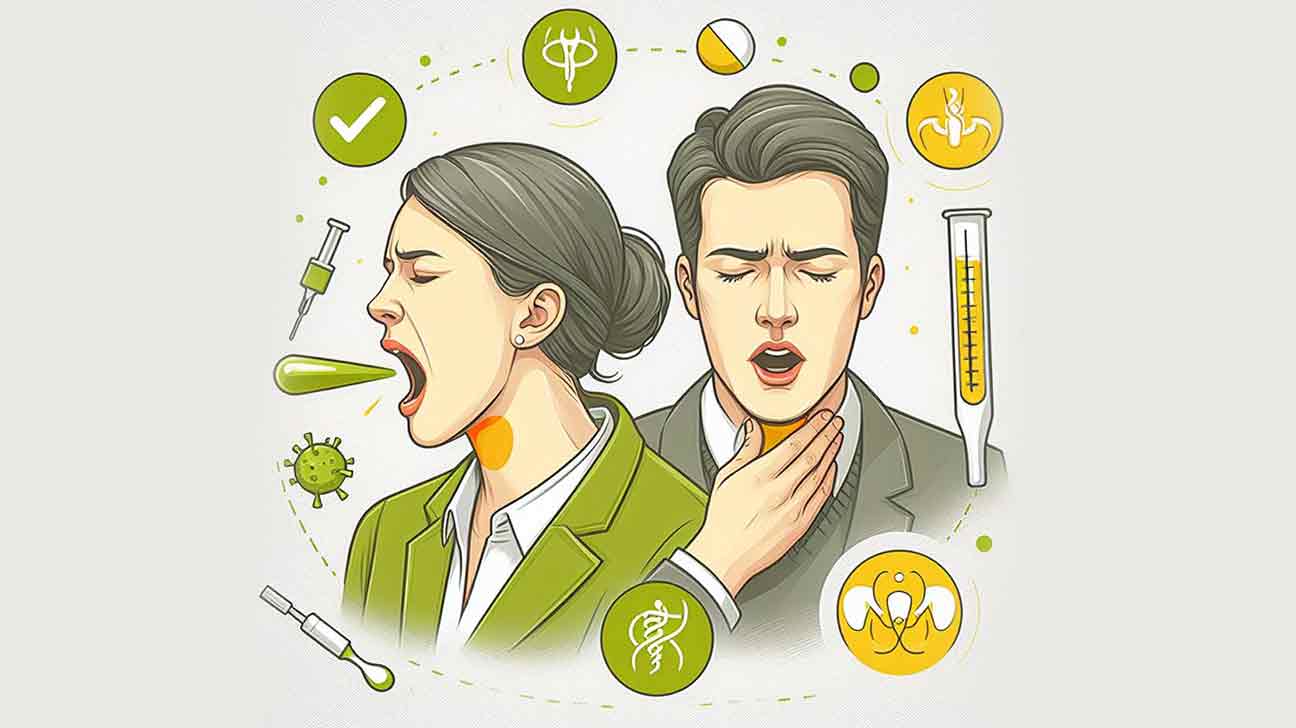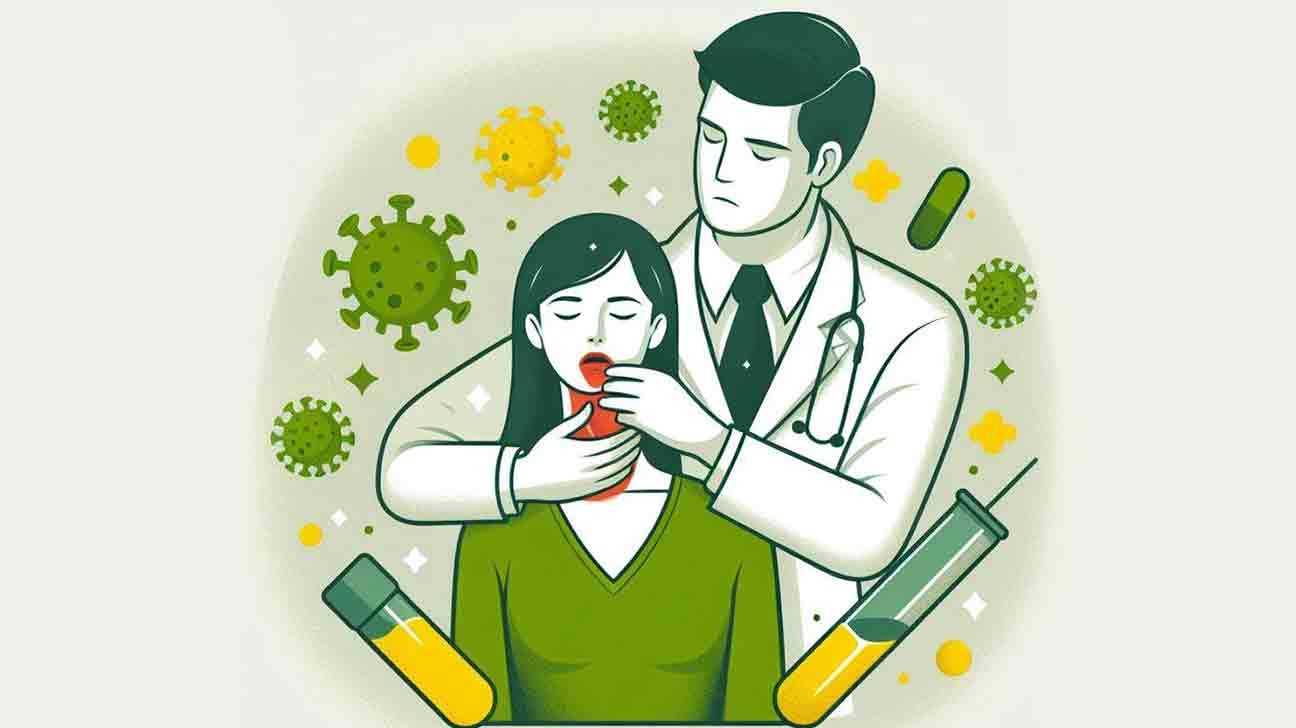
Strep Throat Symptoms is a bacterial infection causing sore throat and fever. It requires antibiotics for treatment.
Streptococcal pharyngitis, commonly known as strep throat, is a bacterial infection that affects the throat and tonsils. It is caused by the streptococcus bacteria and is characterized by symptoms such as a sore throat, fever, and difficulty swallowing. Strep throat is commonly treated with antibiotics to clear the infection and prevent complications.
If left untreated, strep throat can lead to more serious conditions such as rheumatic fever or kidney inflammation. Proper diagnosis and prompt treatment are essential to manage strep throat effectively and prevent its spread to others.
Strep
Strep, short for streptococcus, is a group of bacteria that can cause various infections in the body, such as strep throat and skin infections. It is important to seek medical treatment if you suspect a strep infection to prevent complications and spread of the bacteria.
Understanding Strep
Strep throat is a bacterial infection that causes inflammation and pain in the throat. It is caused by the tococcus bacteria and can affect people of all ages. Here’s what you need to know about strep:
Symptoms And Diagnosis
- Sore throat: A common symptom of strep throat is a sudden and severe sore throat.
- Difficulty swallowing: Strep throat can make it painful to swallow.
- Swollen tonsils: In some cases, the tonsils may be visibly swollen and red.
- Fever: Strep throat can cause a high fever, often over 101°F.
- Red spots: Some people with strep throat develop tiny red spots on the roof of the mouth.
Treatment And Prevention
- Antibiotics: Strep throat is often treated with antibiotics to prevent complications and speed up recovery.
- Pain relief: Over-the-counter pain relievers can help alleviate the discomfort associated with strep throat.
- Hydration: Drinking plenty of fluids can help soothe a sore throat and prevent dehydration.
- Good hygiene: Practicing good hygiene, such as washing hands regularly, can help prevent the spread of strep throat.
Complications And Risks
- Rheumatic fever: If left untreated, strep throat can lead to rheumatic fever, a serious inflammatory condition.
- Scarlet fever: In some cases, strep throat can lead to scarlet fever, characterized by a red rash.
- Kidney inflammation: Strep throat can cause inflammation of the kidneys if not promptly treated.
Strep throat is a common and treatable infection, but it’s essential to recognize the symptoms and seek medical attention for proper diagnosis and treatment. Following the prescribed treatment and taking preventive measures can help minimize the risks associated with strep throat.
Strep Throat
Strep throat is a bacterial infection that causes sore throat, fever, and difficulty swallowing. It is treated with antibiotics to prevent complications and spread. Seeking medical advice is crucial for accurate diagnosis and appropriate treatment.
Understanding Strep Throat
Strep throat is a common bacterial infection that affects the throat and tonsils. It is caused by the streptococcus bacteria and is highly contagious. Here is what you need to know about :
- Sore Throat: One of the main symptoms of strep throat is a severe sore throat that may make swallowing painful.
- Fever: Individuals with strep throat often experience a high fever, typically above 101°F.
- Swollen Tonsils: The tonsils may appear red and swollen with white patches or streaks of pus.
- Headache and Body Aches: Strep throat can also cause headaches, body aches, and general fatigue.
- Rapid Onset: Strep throat symptoms usually develop quickly, with sudden onset of severe throat pain.
If you suspect you have strep throat, it’s important to seek medical attention for proper diagnosis and treatment. Antibiotics are commonly prescribed to treat strep throat and prevent potential complications. Remember to practice good hygiene to prevent the spread of this contagious infection.

Strep Throat Symptoms
Strep throat symptoms may include sore throat, difficulty swallowing, and swollen lymph nodes. Other signs can be fever, headache, and rash. Seeking medical attention is crucial for accurate diagnosis and treatment.
Strep throat is a bacterial infection that affects the throat and tonsils. It is essential to recognize the symptoms of strep throat to seek timely medical attention.
Common Symptoms:
- Sore throat: A persistent and severe sore throat is a key indicator of strep throat. It may make swallowing difficult.
- Fever: A high fever, often above 101 degrees Fahrenheit, is a common symptom of strep throat.
- Swollen lymph nodes: The glands in the neck may become tender and swollen.
- White patches: The throat may develop white patches or streaks of pus.
- Red and swollen tonsils: Tonsils may appear red and inflamed, often with white or yellow patches.
These symptoms can vary in severity, and not all individuals will experience all of them. If you notice any of these symptoms, especially in combination, it is important to consult a healthcare professional for an accurate diagnosis and appropriate treatment.
Symptoms Of Strep Throat
Strep throat is a bacterial infection that causes a sore throat, fever, and swollen lymph nodes. Other symptoms may include difficulty swallowing, headache, and fatigue. It is important to seek medical attention if you suspect you have strep throat, as it can lead to more serious complications if left untreated.
Strep throat is a common bacterial infection that affects the throat and tonsils. It can cause discomfort, pain, and other symptoms that can make it hard to eat, drink, or even talk. If you suspect you have strep throat, it’s essential to seek medical attention promptly.
In this section, we’ll explore the and help you understand what to look out for.
Common Symptoms Of Strep Throat:
- Sore throat that comes on quickly
- Painful swallowing
- Swollen tonsils
- White or yellow spots on the back of the throat
- Headache
- Fever
- Chills
- Nausea and vomiting
- Body aches
- Rash
Strep throat can affect anyone, but it’s most common in children between the ages of 5 and 15. The symptoms can vary depending on the severity of the infection, but typically they begin to show within two to five days after exposure to the bacteria.
If you notice any of these symptoms, it’s essential to visit your doctor or healthcare provider.
Complications Of Untreated Strep Throat:
- Rheumatic fever
- Kidney inflammation
- Ear infections
- Sinus infections
- Abscess near the tonsils
- Scarlet fever
If left untreated, strep throat can lead to more severe health problems, such as rheumatic fever, which can cause permanent damage to the heart. It’s crucial to seek medical attention if you suspect you have strep throat to avoid any complications.
Strep throat can be a painful and uncomfortable experience. Recognizing the symptoms and seeking medical attention promptly can help prevent complications and speed up recovery time.
Is Strep Throat Contagious
Strep throat is highly contagious and spreads easily through coughs and sneezes. It is important to practice good hygiene and avoid close contact with infected individuals to prevent the spread of the bacteria.
Strep throat is a bacterial infection that can cause a sore throat, fever, and swollen lymph nodes. It’s a common condition that affects people of all ages, but is most common in children between the ages of 5 and 15.
If you or someone you know has strep throat, you may be wondering if it’s contagious. In this blog post, we’ll answer that question and more.
What Is Strep Throat?
Strep throat is a bacterial infection caused by group A Streptococcus bacteria. It’s spread through contact with an infected person’s saliva or nasal secretions, such as through coughing or sneezing. Strep throat can also be spread through touching objects that have been contaminated with the bacteria, such as doorknobs or utensils.
Is Strep Throat Contagious?
Yes, strep throat is contagious. The bacteria that cause strep throat can be easily spread from person to person through contact with saliva or nasal secretions. This means that if someone in your household has strep throat, there’s a good chance that others in the household will also become infected.
How Long ?
Strep throat is contagious for as long as a person has symptoms, which usually lasts between 5 and 7 days. However, even after symptoms have subsided, a person can still be contagious for up to 3 weeks if they don’t receive treatment.
How Can You Prevent The Spread Of Strep Throat?
The best way to prevent the spread of strep throat is to practice good hygiene. This includes:
- Washing your hands frequently with soap and water
- Covering your mouth and nose when you cough or sneeze
- Avoiding sharing utensils, cups, or other personal items
- Disinfecting surfaces that may be contaminated with the bacteria
If you do come into contact with someone who has strep throat, it’s important to monitor yourself for symptoms and seek treatment if necessary.
How Is Strep Throat Treated?
Strep throat is usually treated with antibiotics, which can help to reduce symptoms and prevent complications. It’s important to finish the entire course of antibiotics, even if symptoms improve before the medication is finished. In addition to antibiotics, over-the-counter pain relievers and throat lozenges can help to relieve symptoms.
Strep throat is a contagious bacterial infection that can be easily spread from person to person. It’s important to practice good hygiene and seek treatment if necessary to prevent the spread of the infection and reduce symptoms.

What Does Strep Throat Look Like
Strep throat typically presents as a sore, red throat with white patches, swollen tonsils, and sometimes tiny red spots at the back of the roof of the mouth. Other symptoms may include fever, headache, and difficulty swallowing. Seeking medical advice is important for accurate diagnosis and treatment.
Strep throat is a bacterial infection that affects the throat and tonsils. It is important to recognize the symptoms of strep throat in order to seek appropriate treatment. Here’s what strep throat looks like:
- Sore Throat: The most common symptom of strep throat is a severe sore throat that develops suddenly and is often accompanied by pain when swallowing.
- Red and Swollen Tonsils: The tonsils may appear red and swollen, sometimes with white patches or streaks of pus.
- Swollen Lymph Nodes: The lymph nodes in the neck may become tender and swollen.
- Fever: Strep throat can cause a high fever, usually over 101 degrees Fahrenheit.
- Tiny Red Spots: In some cases, tiny red spots may appear at the back of the roof of the mouth.
These visual indications, combined with other symptoms such as headache, nausea, or vomiting, may suggest the presence of strep throat. If you notice these signs, it’s essential to consult a healthcare professional for a proper diagnosis and treatment.
Strep Throat Treatment
Combatting strep throat involves a regimen of antibiotics prescribed by a medical professional. Treatment typically lasts 10 days to fully eradicate the infection. Additionally, rest and staying hydrated are essential for a speedy recovery.
Strep throat can be a painful condition, but with the right treatment, you can recover quickly and effectively. Here are some essential methods to help alleviate strep throat symptoms and promote healing:
- Antibiotics:
Antibiotics are often prescribed by healthcare providers to combat the bacterial infection causing strep throat. It is crucial to complete the full course of antibiotics as directed to ensure the infection is fully eradicated.
- Pain Relief Medications:
Over-the-counter pain relievers such as ibuprofen or acetaminophen can help reduce the discomfort associated with strep throat. These medications can also help lower fever and relieve throat pain.
- Rest and Hydration:
Getting plenty of rest and staying hydrated are essential components of. Rest allows your body to focus on fighting the infection, while staying hydrated helps soothe a sore throat and prevent dehydration.
- Saltwater Gargle:
Gargling with warm salt water can help alleviate throat pain and reduce inflammation. Mix a teaspoon of salt in a glass of warm water and gargle several times a day for relief.
- Throat Lozenges:
Throat lozenges or sprays can provide temporary relief from throat irritation and pain. Look for lozenges with ingredients like menthol or eucalyptus for added soothing effects.
Remember, it is essential to consult with a healthcare professional for an accurate diagnosis and appropriate treatment plan for strep throat. By following these treatment methods and taking care of yourself, you can recover from strep throat and get back to feeling your best in no time.
Strep Throat Pictures
Strep throat pictures show the visual symptoms of a common bacterial infection affecting the throat. These images help in identifying the characteristic redness and white patches associated with strep throat. Understanding the visual cues can aid in prompt diagnosis and treatment.
Understanding Strep Throat Pictures
Strep throat is a common bacterial infection that can cause various symptoms, including throat pain, difficulty swallowing, and swollen tonsils. In some cases, it may lead to complications if left untreated. Understanding what strep throat looks like can help in identifying the condition and seeking appropriate medical care.
Here, we’ll explore the visual aspects of strep throat through pictures and discuss the characteristics to watch out for.
Visual Signs Of Strep Throat:
- Redness and Swelling: Strep throat can cause the throat to appear red and inflamed. This visual indication often accompanies discomfort and difficulty swallowing.
- White Patches or Streaks: The presence of white patches or streaks on the tonsils or at the back of the throat is a common sign of strep throat. These patches may indicate the accumulation of pus, a result of the bacterial infection.
- Enlarged Tonsils: Strep throat can lead to visibly enlarged tonsils, often accompanied by a white or yellow coating. This visual symptom can be a key indicator of the infection.
Identifying Strep Throat In Pictures:
When viewing images of strep throat, it’s important to focus on the specific visual cues that indicate the presence of the infection. Look for the redness and swelling in the throat, as well as any white patches or streaks on the tonsils.
Additionally, note any enlargement of the tonsils, which can further support the diagnosis of strep throat. By familiarizing oneself with these visual signs, individuals can better recognize the condition and seek timely medical attention if necessary.
Understanding the visual indicators of strep throat through pictures is valuable in identifying and addressing the infection promptly. Recognizing the characteristic redness, swelling, white patches, and enlarged tonsils can aid in early detection and treatment. If you suspect that you or someone you know may have strep throat based on visual symptoms, it’s essential to consult a healthcare professional for proper evaluation and management.
Signs Of Strep Throat
Strep throat may cause symptoms like sore throat, fever, and swollen tonsils. White patches at the back of the throat can also indicate strep infection. Seeking medical advice is crucial for accurate diagnosis and treatment.
Strep throat is a bacterial infection that can cause discomfort and pain. Recognizing the is crucial for timely treatment and recovery. Here are the common signs and symptoms of strep throat:
- Sore throat: A persistent, severe sore throat is a hallmark symptom of strep throat. It often feels scratchy and painful, making swallowing difficult.
- Fever: Strep throat can cause a sudden, high fever, typically over 101°F (38.3°C).
- Swollen tonsils: The tonsils may appear red and swollen, often with white or yellow patches of pus.
- Headache: Many people with strep throat experience headaches, often accompanied by body aches.
- Swollen lymph nodes: The glands in the neck may become tender and swollen.
- Rash: In some cases, a red rash may develop, particularly on the neck and chest.
Recognizing these signs can help in seeking prompt medical attention and appropriate treatment for strep throat.

How To Get Rid Of Strep Throat Overnight
To alleviate strep throat overnight, try gargling with warm salt water, drinking herbal teas, and resting adequately. Additionally, using a humidifier and consuming soothing foods like honey can help soothe the throat and promote faster recovery.
Strep throat can be a painful and uncomfortable experience, but there are ways to alleviate the symptoms and speed up your recovery. Here are some effective tips to help you get rid of strep throat quickly:
Home Remedies:
- Gargle with warm salt water: This can help reduce throat inflammation and kill bacteria.
- Stay hydrated: Drink plenty of fluids to keep your throat moist and help flush out toxins.
- Rest and relax: Give your body the rest it needs to fight off the infection.
- Use a humidifier: Moist air can soothe your throat and help you breathe easier.
- Drink herbal teas: Chamomile or ginger tea can provide relief and boost your immune system.
Over-the-counter Medications:
- Pain relievers: Take ibuprofen or acetaminophen to reduce pain and fever.
- Throat lozenges: Sucking on lozenges can help soothe a sore throat.
- Antibiotics: If prescribed by your doctor, antibiotics can help treat the infection.
Remember, it’s essential to consult a healthcare professional before trying any new treatments or medications. By following these tips, you can help alleviate the discomfort of strep throat and promote a speedy recovery.
How Long Is Strep Contagious
Strep is contagious for about 24 to 48 hours after starting antibiotics. It can spread through respiratory droplets. Good hygiene practices can help prevent the spread of strep bacteria.
Understanding Strep Contagious Period
Strep throat is a common bacterial infection that can easily spread from person to person through respiratory droplets. Knowing how long strep is contagious is crucial in preventing its transmission. Below are key points to understand the contagious period of strep throat:
- Contagious Period: Strep throat is contagious for up to 2-3 weeks if left untreated. It is important to note that antibiotics can reduce the contagious period to as little as 24 hours after treatment initiation.
- Early Containment: To prevent the spread of strep throat, individuals should avoid close contact with infected persons, practice good hygiene, and cover their mouth and nose when sneezing or coughing.
- Recovery Time: Most individuals start feeling better within a few days of starting antibiotics treatment. However, completing the full course of antibiotics is essential to ensure complete recovery and reduce the risk of recurrence.
- Returning to Activities: Individuals with strep throat should stay home from school or work until they have been on antibiotics for at least 24 hours and are feeling well enough to resume normal activities.
Understanding the contagious period of strep throat is vital for effective management and prevention of its spread. By following proper precautions and completing treatment as prescribed, individuals can help limit the transmission of this bacterial infection.
What Is Strep Throat
Strep throat is a bacterial infection that causes a sore, scratchy throat and difficulty swallowing. It is highly contagious and can be spread through respiratory droplets. Symptoms include fever, swollen tonsils, and white patches at the back of the throat.
Treatment typically involves antibiotics to alleviate symptoms and prevent complications.
Strep throat is a common bacterial infection that affects the throat and tonsils. It is caused by the Streptococcus pyogenes bacteria and is highly contagious. Here are some key points about strep throat:
- Symptoms:
- Sore throat with white patches
- Difficulty swallowing
- Swollen lymph nodes in the neck
- Diagnosis:
- Throat swab test
- Rapid strep test
- Physical examination
- Treatment:
- Antibiotics prescribed by a doctor
- Rest and plenty of fluids
- Over-the-counter pain relievers for discomfort
- Prevention:
- Wash hands frequently
- Avoid sharing utensils or drinks
- Cover mouth when coughing or sneezing
Strep throat can be easily treated with antibiotics, but if left untreated, it can lead to complications such as rheumatic fever or kidney inflammation. It is important to consult a healthcare provider if you suspect you or your child has strep throat.
How Contagious Is Strep Throat
Strep throat is highly contagious and spreads through respiratory droplets from coughing or sneezing. Close contact with an infected person or sharing items like utensils can also transmit the bacteria. It’s important to practice good hygiene and seek medical attention for prompt treatment.
Understanding Strep Throat Contagiousness
Strep throat is a bacterial infection that affects the throat and tonsils. The degree of contagion of strep throat can vary depending on several factors. Here’s a breakdown of how contagious strep throat can be:
- Contagious Period: Strep throat is most contagious during the initial stages of infection when symptoms like sore throat, fever, and swollen lymph nodes are prevalent. The contagious period typically lasts until the infected individual has been on antibiotics for at least 24 hours.
- Mode of Transmission: Strep throat spreads through respiratory droplets when an infected person coughs, sneezes, or talks. Direct contact with contaminated surfaces or objects can also lead to transmission.
- Household Settings: Strep throat is highly contagious in close quarters such as households, schools, and daycare centers. Sharing utensils, towels, or personal items can facilitate the spread of the bacteria.
- Risk Factors: Individuals with weakened immune systems, young children, and those who are in close contact with infected individuals are at a higher risk of contracting strep throat.
Preventing The Spread Of Strep Throat
Taking proactive measures to prevent the spread of strep throat is crucial in minimizing the risk of infection. Here are some effective strategies to reduce contagion:
- Practice Good Hygiene: Encourage frequent handwashing with soap and water, especially after coughing, sneezing, or touching potentially contaminated surfaces.
- Avoid Close Contact: Limit close contact with individuals who have been diagnosed with strep throat, especially during the contagious period.
- Disinfect Surfaces: Regularly disinfect commonly touched surfaces and objects to prevent the spread of bacteria.
- Cover Your Mouth: Encourage individuals to cover their mouth and nose with a tissue or their elbow when coughing or sneezing to prevent respiratory droplets from spreading.
By understanding the contagious nature of strep throat and implementing preventive measures, individuals can help curb the spread of this bacterial infection.
How To Get Rid Of Strep Throat
To alleviate strep throat, gargle with warm salt water, stay hydrated, and rest to boost recovery. Over-the-counter pain relievers can help manage discomfort, while antibiotics may be prescribed by a healthcare provider for severe cases. Proper hygiene and avoiding close contact can prevent the spread of the infection.
Strep throat can be a painful and uncomfortable experience, but there are several ways to alleviate symptoms and speed up the recovery process. Here are some effective methods to help you get rid of strep throat:
Home Remedies For Strep Throat
- Gargle with warm saltwater: This can help reduce throat inflammation and provide temporary relief from discomfort.
- Stay hydrated: Drinking plenty of fluids can keep your throat moist and soothe irritation.
- Use a humidifier: Adding moisture to the air can ease throat pain and prevent dryness.
- Rest: Giving your body adequate rest can help strengthen the immune system and promote faster recovery.
Over-the-counter Medications
- Pain relievers: Over-the-counter pain medications like ibuprofen or acetaminophen can help alleviate throat pain and reduce fever.
- Throat lozenges: Sucking on throat lozenges can provide temporary relief from soreness and irritation.
Medical Treatment
- Antibiotics: If your strep throat is confirmed through a throat swab, your healthcare provider may prescribe antibiotics to help clear the infection and prevent complications.
- Follow the prescribed treatment: It’s essential to complete the full course of antibiotics as directed by your healthcare provider to ensure the infection is fully eradicated.
Dealing with strep throat can be challenging, but by following these strategies, you can effectively manage the symptoms and promote a speedy recovery.
Frequently Asked Questions
What Are The 4 Symptoms Of Strep?
The 4 symptoms of strep are: sore throat, difficulty swallowing, red and swollen tonsils, and fever.
How Do You Get Strep?
Strep throat is caused by a bacteria called Group A Streptococcus. It is spread through close contact with an infected person’s respiratory secretions, such as coughing or sneezing. You can also get it by touching an object contaminated with the bacteria and then touching your mouth or nose.
Can Strep Go Away On Its Own?
Strep throat usually requires treatment with antibiotics to go away completely. Without proper treatment, it can lead to serious complications and may not go away on its own. It’s important to see a healthcare provider if you suspect you have strep throat.
What Does Strep Throat Cause?
Strep throat causes throat pain, difficulty swallowing, swollen lymph nodes, and fever. It is important to seek medical treatment to prevent complications.
Conclusion
Understanding strep throat symptoms and treatments is crucial for overall health. Remember, early detection and proper care are key to managing this common infection. Stay informed, seek medical advice, and prioritize your well-being to combat strep effectively. Your health matters most.

